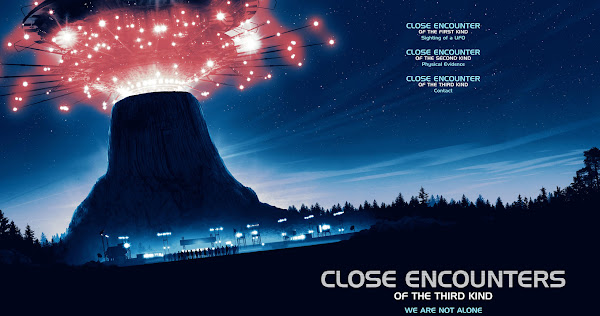Close Encounters of the Third Kind (1977)

“Close Encounters of the Third Kind,” directed and written by Steven Spielberg and released in 1977, is a landmark film in the science fiction genre. Renowned for its groundbreaking special effects and thought-provoking narrative, the film explores humanity’s relationship with extraterrestrial life while delving into themes of curiosity, communication, and the quest for understanding. With an outstanding cast, including Richard Dreyfuss, Melinda Dillon, Teri Garr, and François Truffaut, “Close Encounters” has left an enduring legacy in cinematic history.
The story revolves around Roy Neary, played by Richard Dreyfuss, an everyday family man who becomes captivated by a series of mysterious events after witnessing a UFO while working on a night shift. This encounter profoundly impacts his life, leading him to experience vivid visions and an obsessive desire to understand what he has seen. The film begins with a sense of wonder and mystery, gradually escalating into a thrilling exploration of the unknown.
One of the film’s most compelling aspects is its portrayal of communication, not only between humans but also between humans and extraterrestrials. Roy’s obsession is mirrored by a group of scientists led by Claude Lacombe, portrayed by François Truffaut. Lacombe and his team are dedicated to studying the phenomena surrounding UFO sightings and deciphering the signals emitted by the extraterrestrial visitors. Their quest highlights the importance of understanding and communication as they work to establish contact with the unknown.
As Roy’s visions become increasingly intense, he begins to sculpt a mountain out of mashed potatoes, a visual representation of his subconscious connection to the aliens. This act serves as a metaphor for his inner turmoil and yearning for something beyond the ordinary. The iconic imagery of the mountain is a pivotal moment in the film, symbolizing the intersection of human experience and the cosmic mysteries that lie beyond our comprehension.
The cinematography in “Close Encounters” is breathtaking, capturing the beauty and vastness of the night sky. Spielberg’s direction skillfully balances suspense and wonder, immersing audiences in the experience of encountering the unknown. The use of practical effects and innovative techniques, such as the depiction of the UFOs and their interaction with the environment, was groundbreaking for its time. The film’s visual effects continue to be celebrated for their realism and artistry, contributing to its lasting impact on the genre.
The film’s score, composed by John Williams, is another critical element that elevates the narrative. The music, particularly the iconic five-note motif used for communication with the extraterrestrials, creates an emotional resonance that enhances the film’s themes of connection and exploration. The score effectively builds tension and evokes feelings of awe, underscoring the wonder of the universe and the possibilities that lie beyond our planet.

As the story progresses, we witness the effects of Roy’s obsession on his family life, particularly on his wife, Gillian, portrayed by Melinda Dillon. Gillian also experiences her own close encounter when her son is taken by the aliens, leading her to join Roy in the search for answers. Their parallel journeys highlight the film’s exploration of the personal impact of extraordinary experiences, illustrating how encounters with the unknown can challenge and reshape our lives.

The climax of the film occurs at Devil’s Tower, a monumental rock formation in Wyoming that serves as a landing site for the extraterrestrial visitors. The visual spectacle of the UFOs arriving at this iconic location is a culmination of tension and wonder, bringing together the film’s themes of connection and discovery. The final scenes depict the breathtaking encounter between humans and aliens, culminating in a sense of hope and unity that transcends the fear and uncertainty that preceded it.

In conclusion, “Close Encounters of the Third Kind” is a masterful exploration of humanity’s quest for understanding and connection with the cosmos. Steven Spielberg’s direction, combined with Richard Dreyfuss’s compelling performance and John Williams’ unforgettable score, creates an immersive cinematic experience that resonates with audiences on multiple levels. The film challenges viewers to consider their place in the universe, the nature of communication, and the profound mysteries that lie beyond our understanding. As a cornerstone of science fiction cinema, “Close Encounters” continues to inspire and captivate, reminding us of the beauty and wonder of the unknown











